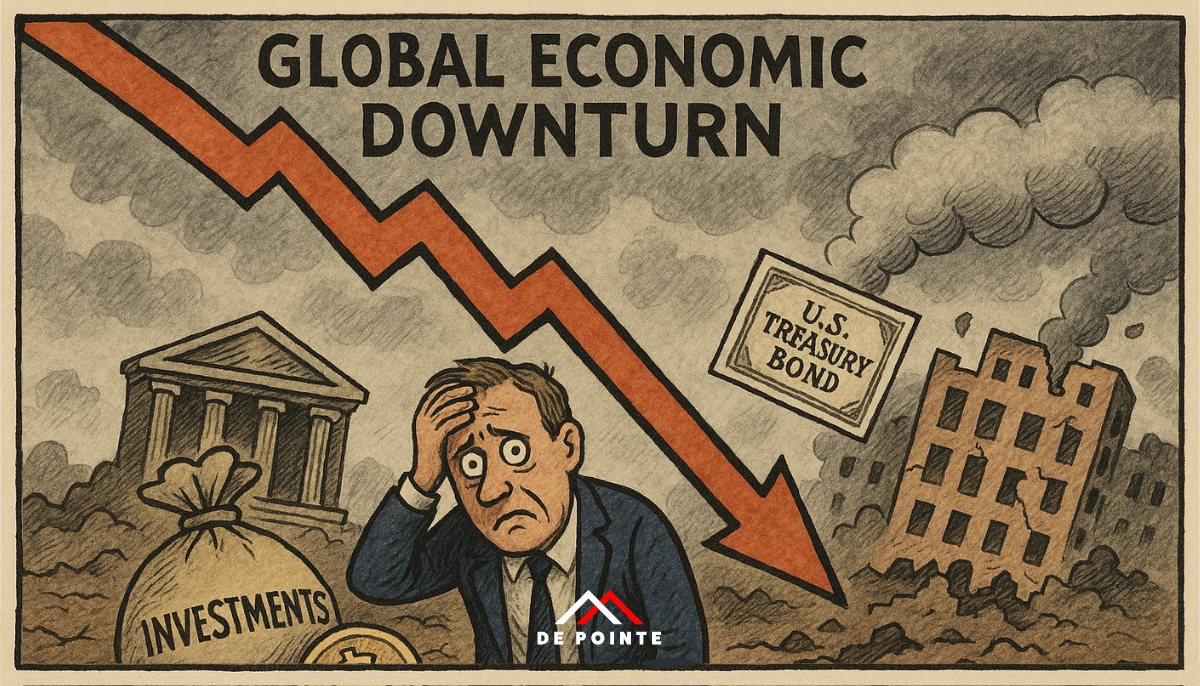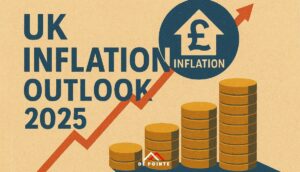Article

The world economy is once again navigating dangerous waters. The global financial system is under immense pressure, from aggressive tariffs and retaliatory trade measures to rising inflation and volatile markets. For investors, these moments of uncertainty can feel overwhelming—but they also create an opportunity to reassess, reposition, and future-proof their portfolios.
At De Pointe Research, we specialise in identifying moments like these—when conventional thinking falls short and intelligent capital looks to alternative strategies for stability and growth. This in-depth article explores the drivers behind the current economic downturn, analyses its impact on traditional investments, and highlights how forward-thinking investors prepare for what’s next.
What’s Causing the 2025 Economic Downturn?
The 2025 downturn cannot be pinned on a single cause. Instead, it results from a confluence of interrelated macroeconomic factors, the most significant of which is the resurgence of trade protectionism.
1. Tariffs and Trade Wars
On April 2nd, 2025, former President Donald Trump, seeking a return to office, unveiled a series of aggressive tariff policies to protect domestic industries. These included:
- A 10% universal tariff on all imports,
- A 54% tariff on Chinese goods,
- And a 20% tariff on imports from the European Union.
The response from global trade partners was immediate and retaliatory. China imposed counter-tariffs on American goods, while European leaders condemned the move and introduced their protective measures.
This tit-for-tat trade war has not only strained diplomatic ties but also disrupted global supply chains, increased manufacturing costs, and reduced consumer spending power. Growth forecasts have been revised downward in economies reliant on international trade, such as Germany, Japan, and South Korea.
2. Inflationary Pressures
Even before tariffs were introduced, inflation remained stubbornly high in many advanced economies. Now, with trade barriers raising the cost of imported goods and squeezing margins, the cost of living has risen further. Central banks, which had already deployed rate hikes over the last two years, now find themselves walking a tightrope: act too aggressively, and they risk triggering recession; act too cautiously, and inflation persists.
3. Consumer Confidence and Business Investment Declines
The psychological toll of prolonged uncertainty is difficult to quantify—but its impact on investment and consumer spending is clear. OECD and World Bank surveys show a marked decline in consumer confidence indices and a reluctance among businesses to invest in long-term projects. With capital sitting on the sidelines, productivity suffers, employment stagnates, and economic recovery becomes more elusive.
How the Downturn is Impacting Traditional Investments
With the macroeconomic backdrop in disarray, traditional investment markets are under strain. Let’s break down what’s happening across the three major conventional asset classes.
1. Equities
Stock markets have seen sharp corrections in Q1 and Q2 of 2025. The S&P 500 and NASDAQ are down significantly year-to-date, and other global indices have followed suit.
Sectors such as:
- Technology, which relies on complex international supply chains,
- Manufacturing, sensitive to input cost changes,
- And retail, which is directly affected by declining consumer sentiment,
…have all experienced double-digit percentage drops.
Dividend yields are rising—not as a sign of strong fundamentals, but because share prices are falling. Growth expectations have been revised downward, and many analysts anticipate continued earnings disappointments in the quarters ahead.
2. Bonds and Treasuries
US Treasuries, usually a safe harbour during market turbulence, have defied expectations. Despite weaker economic growth, 10-year yields remain elevated, hovering above 4%. This is an unusual phenomenon—suggesting that investors fear recession and stagflation.
With inflation outpacing interest payments, real returns on fixed-income investments are negative. Traditional bond-heavy portfolios (including pension funds and retirement vehicles) are being re-evaluated as the usual diversification benefits fail to materialise.
3. Cash and Savings Instruments
While rising interest rates have made cash and short-term instruments more appealing, inflation continues to erode their real value. With CPI inflation still running well above target in the UK and US, holding cash remains a losing strategy in real terms.
Likely Outcomes: Where Do We Go From Here?
Looking ahead, leading economists are considering two primary economic scenarios.
Scenario A: Prolonged Stagflation
Suppose trade disputes continue and central banks remain constrained in their responses. In that case, we could look at a multi-year stagflation period—slow or no growth, high unemployment, and persistent inflation. This would resemble the economic malaise of the 1970s and early 1980s when traditional investment tools failed to deliver inflation-adjusted returns.
Scenario B: Policy Pivot and Gradual Recovery
Should policymakers shift course—either by softening tariffs, engaging in trade negotiations, or implementing coordinated fiscal stimulus—markets could find a firmer footing. This more optimistic outcome might stabilise in late 2025, with recovery building into 2026.
However, even in this scenario, the performance of traditional equities and bonds is expected to remain subdued compared to historical norms.
What Smart Investors Are Doing Differently
Given the landscape, we see increased demand for uncorrelated, inflation-hedged, and tangible assets—investment classes less impacted by geopolitical noise and macroeconomic cycles.
Alternative Assets on the Rise
- Fine Art
As tracked by the Knight Frank Luxury Investment Index, fine art has consistently outperformed traditional markets in recent years—delivering 11% in 2023 and 29% in 2022. Art offers:
- Low correlation to equities and bonds,
- Inflation hedging potential,
- And a finite supply in an increasingly globalised collector base.
At De Pointe, we conduct deep due diligence into curated art opportunities with 20%+ historical annual returns, providing clients with direct exposure to this lucrative market.
- Gold
A time-honoured inflation hedge, gold is once again proving its mettle. Its value tends to rise during economic uncertainty, and with geopolitical risks mounting, demand has surged from both institutional and retail investors.
- Private Credit and Lending
Alternative lending platforms, short-duration debt, and direct lending funds offer attractive yields without exposure to public market volatility. These assets are gaining traction, especially among high-net-worth individuals seeking dependable income.
The De Pointe View: Allocating Capital in a Crisis
Our position is clear: the traditional 60/40 portfolio model is no longer fit for purpose in an era of high inflation and geopolitical instability. Investors must look beyond the mainstream to protect and grow their capital.
We recommend:
- Reducing overexposure to equities and long-duration bonds,
- Reallocating 10–20% of your portfolio to tangible, inflation-resistant alternatives,
- And staying educated with research-backed insights to make proactive investment decisions.
2025 is shaping up to be a defining year for the global economy and investors worldwide. Traditional assumptions are being tested, correlations are breaking down, and the need for intelligent diversification has never been greater.
At De Pointe Research, we help subscribers cut through the noise, identify genuine opportunities, and build portfolios designed to withstand uncertainty.
If you’re rethinking your investment strategy amid this economic downturn, our team is here to guide you through the landscape of secure, high-performing alternative investments.





